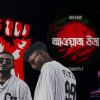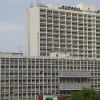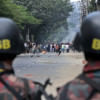Witnessing the quota reform protests as a high school student

I sit in my living room, watching the unrest through a screen. There's a certain futility about being a high school student during such times – you're too old to live in ignorance but, at the same time, too young to fully participate in these protests.
That being said, the youth have other advantages – an acute eye for recognising injustice and an undying will to fight.
At the time of writing this article, the quota reform protests have been going on for several days. From blockades to rallies, protestors have expressed their dissatisfaction with the existing quota system in many ways. Among the masses that attended the rallies in the last few days, a significant portion consisted of students from various high schools.
Nazmus Sakib*, a school-going student, joined the absentee funeral that took place on the afternoon of July 17. He speaks about his experience there.
"There was an eeriness in the atmosphere that I cannot really explain," said Sakib. "It seemed that there were many undercover law enforcement personnel present over there. Of course, the students present at the absentee funeral were doing nothing wrong. Even then, I could sense that they were somewhat afraid, probably fearing that they might be attacked at any given moment."

"It was not a random event with random students who did not know what they were protesting for," Sakib added. "Every single person who was present over there knew what the protest was all about and why it was so unfair."
The day before the absentee funeral that Sakib attended, on July 16, the protestors put up a blockade from Asad Gate to Dhanmondi 27. Several high school students took part in this blockade, one of whom was fifteen-year-old Minhaz Abedin*, a student of class nine from Dhanmondi Government Boys' High School.
Sharing his experience at this particular protest, Abedin said, "I did not know anyone there, but they were all so helpful. An older female student gave me her marker to make posters and also helped me make them. Even though I was afraid, watching these strangers become my own people and reaching out felt very reassuring."
Amidst the rumours and threats of violence against protestors circulating on social media, the sheer courage of these protestors is tremendously admirable. Another protestor at the Asad Gate blockade, Sameer Sakin*, a student of class eleven at St. Joseph Secondary High School, shared how demoralising these threats can be.
"Much like anyone else, I also felt dispirited due to the existing threats," said Sakin. "However, the feeling was short-lived. If anything, the discouragement is why it felt so right to show solidarity with the protest."
When asked about his motivation behind taking part in the rallies and protests, Sakin aptly named frustration as the cause.
"I have been a penman for a while," he said. "This time, I felt that joining on ground would have more effect than my writing against injustice could have. Living, and doing anything else, but joining the protests felt wrong."
Our young voices do not stop at just joining the protests in person. The majority of our country's young student population took to different social media platforms to make their voices heard on the internet for as long as the internet was still accessible. Spreading awareness, sourcing legitimate news, and debunking rumours are all part of this generation's repertoire.
Raniya Ahmed*, a ninth-grader at Maple Leaf International School, stands among the many online protestors who spoke out. She says, "Hearing about havoc all over the streets, the deaths of unarmed students, yet not being able to do anything myself is the most heart-wrenching feeling ever. The bare minimum I can do now is support them by spreading awareness via the internet, and donations and verbally helping them. The students wanted nothing but justice and the anti-discrimination movement must get its attention globally and prevail."

Such passion and righteousness have always been akin to Bangladeshi youth, be it in 1952, 1971, or 2024. Poems and plays have been written about the bravery in our students' blood. We study them for Bangla lessons and praise them for their unwavering might.
And there are other, more subtle ways of protesting as well. When I first sat down to write this, a friend who is keen on photographic advocacy sent me a picture of a crimson stained sky, taken on July 16. Without mincing her words, she told me she'd felt as though the sky that day had been a reflection.
*Names have been changed to protect identities.
Rubama is a part-time student, part-time activist, and a full-time writer.

 For all latest news, follow The Daily Star's Google News channel.
For all latest news, follow The Daily Star's Google News channel. 








Comments